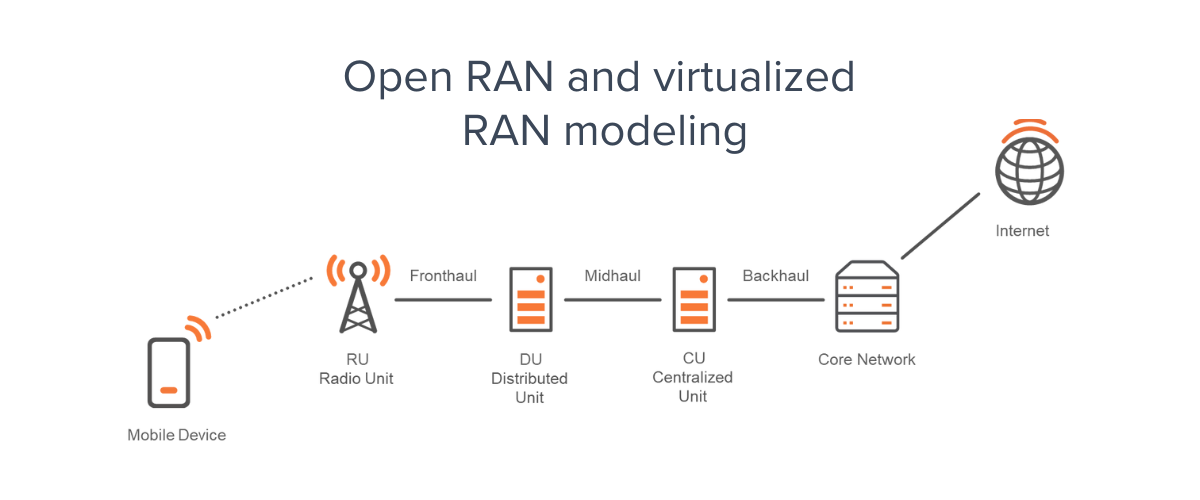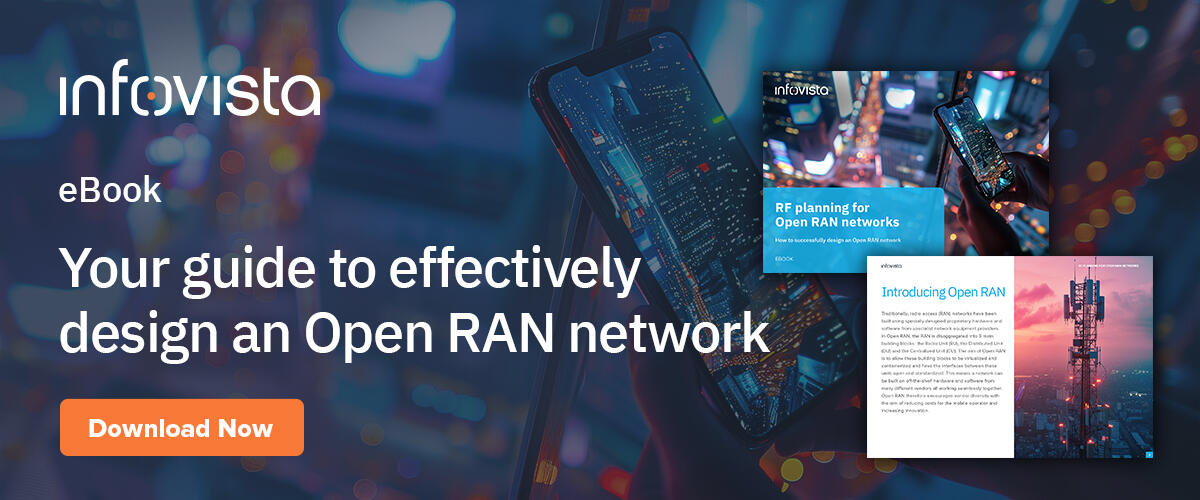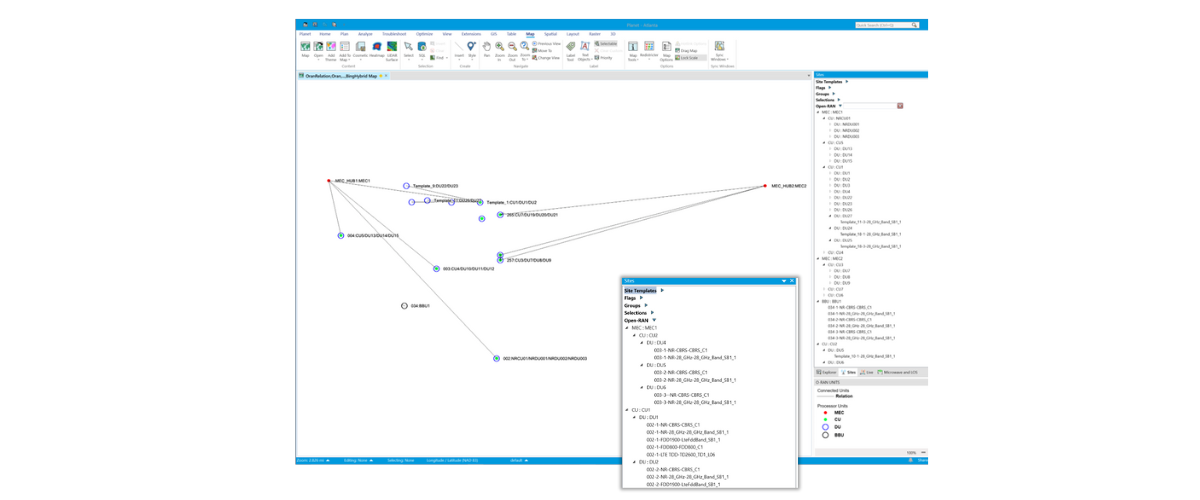In recent years, the telecom industry has been abuzz with talk of Open RAN. This innovative approach promises to transform the way networks are built and operated, offering increased flexibility, cost savings, and vendor diversity. However, as with any technological advancement, the key to reaping these benefits lies in meticulous planning and execution.
Let’s explore the critical considerations and key strategies for planning Open RAN networks, highlighting the importance of high-quality RF planning and the unique challenges and opportunities presented by this new paradigm.
What is Open RAN?
Traditionally, radio access networks (RANs) have been built using proprietary hardware and software from specialized network equipment providers. In contrast, Open RAN disaggregates the RAN into three main components:
- Radio Unit (RU)
- Distributed Unit (DU)
- Centralized Unit (CU)

The goal of Open RAN is to virtualize and containerize these components (RU, DU and CU), with open and standardized interfaces between them. This allows networks to be built using off-the-shelf hardware and software from various vendors, all working seamlessly together.
Open RAN main benefits:
And what is the result? An Open RAN network provides a flexible and cost-effective approach by virtualizing core components and standardizing interfaces, allowing CSPs to use hardware and software from multiple vendors seamlessly.
This open framework encourages vendor diversity, reducing costs and accelerating innovation.
- CSPs benefit from lower infrastructure expenses and greater control over network design, avoiding dependency on a single vendor.
- For enterprises, particularly with private networks, Open RAN offers customization options tailored to specific needs, combined with the agility and savings of a multi-vendor system.
In summary, Open RAN modernizes network deployment, resulting in a more diverse and innovative vendor ecosystem that can drive down costs for mobile operators.

Key strategies for successful Open RAN network planning
Align RF network goals with Open RAN objectives
Radio Frequency (RF) planning is the foundational step in the lifecycle of a network. A poorly planned network can lead to coverage gaps, poor service quality, and costly remediation efforts.
Conversely, over-planning with too many sites can inflate both capital expenditure (CAPEX) and operational expenditure (OPEX), eroding profitability.
Therefore, careful consideration must be given to the planning phase of any new Open RAN network, paying special attention to:
- Coverage and capacity: Proper RF planning ensures that the network has adequate coverage and capacity to meet user demands.
- Cost efficiency: Optimal site placement minimizes both initial setup and ongoing maintenance costs.
- Quality of service: A well-planned network delivers better service quality, leading to higher customer satisfaction and retention.
Follow the 4 key principles of high-quality RF Planning
There are 4 essential requirements for effective RF planning in an Open RAN environment:
- Accuracy - An RF planning tool should create a digital twin of the planned network to simulate its performance. This allows planning engineers to ensure the network will meet technical and business requirements and analyze various "what-if" scenarios.
- Automation - Planning an RF network involves considering millions of potential configurations. Automation is crucial for offloading repetitive tasks, enabling engineers to focus on high-value strategic decisions. It also allows for rapid trial and error, arriving at the optimal configuration in a short time.
- Data-driven decision making - When planning a new network or expanding an existing one, assumptions about traffic and usage can significantly impact performance. Leveraging large data sets can improve these assumptions, leading to better decision making and network performance.
- Integration - RF planning is just one step in building a successful network. Integrating across departmental silos increases efficiency and productivity. Sharing data between departments can also improve overall network operations.
Be backed by essential tools for effective RF Planning
To achieve high-quality RF designs, telecom operators worldwide turn to advanced RF planning and optimization solutions like Infovista’s Planet. This tool delivers accurate and efficient wireless network planning for both traditional and Open RAN architectures.
Open RAN vs traditional RF planning: key considerations to choose the right tool
While the foundational principles of RF planning apply to both traditional and Open RAN networks, there are specific capabilities that an RF planning tool must possess to ensure successful Open RAN deployments:
Support for Open RAN nodes
Accurately representing and modeling an Open RAN network requires support for Open RAN-specific nodes like the RU, DU, and CU. Without this, many advanced planning capabilities are not possible.
Open RAN friendly views
Traditional RF planning tools provide site explorer and map views. For Open RAN, these views must also represent Open RAN nodes, giving engineers a clear picture of the network architecture.
Open RAN Service area plots
The disaggregated nature of Open RAN nodes means there are many options for connecting RUs, DUs, and CUs. RF planning tools must provide insights to enable efficient node connections, optimizing network performance.
Open RAN latency analysis
Latency modeling is critical for offering latency-sensitive services like 5G slicing and Ultra-Reliable Low-Latency Communication (URLLC). Open RAN's virtualized nodes and potential cloud deployments can introduce unexpected latency, making accurate latency analysis essential.
How Infovista Planet empowers effective Open RAN networks design
Infovista Planet equips network planners with essential tools for efficient Open RAN network design, delivering clear, data-driven insights to optimize connectivity, latency, and service quality through the following capabilities:
- Precise network modeling: Supporting RU, DU, and CU nodes, Planet enables accurate Open RAN modeling, ensuring a strong foundation for design and analysis.
- Improved visualization of connections: With physical and logical views, Planet helps engineers clearly see node locations and connections, simplifying complex planning decisions.
- Optimized service area connections: "Best DU" and "Best CU" plots give planners a geographical view of DU and CU areas, aiding strategic node connections based on location, latency, and capacity.
- Ideal placement for latency-sensitive services: Planet’s latency analysis helps planners identify optimal node placements, ensuring latency-sensitive services are well-supported across the network.

Conclusion
Open RAN networks represent a significant shift in network architecture, offering numerous benefits but also presenting unique challenges. Starting with high-quality RF planning is essential to unlock the full potential of Open RAN, ensuring optimal performance, cost-efficiency, and service quality.
Looking for a deep dive? Download the eBook "RF Planning for Open RAN networks” today and get access to advanced insights and tools to capitalize on Open RAN networks.
By leveraging advanced planning tools and focusing on the unique aspects of Open RAN, telecom professionals can successfully navigate this new landscape.








